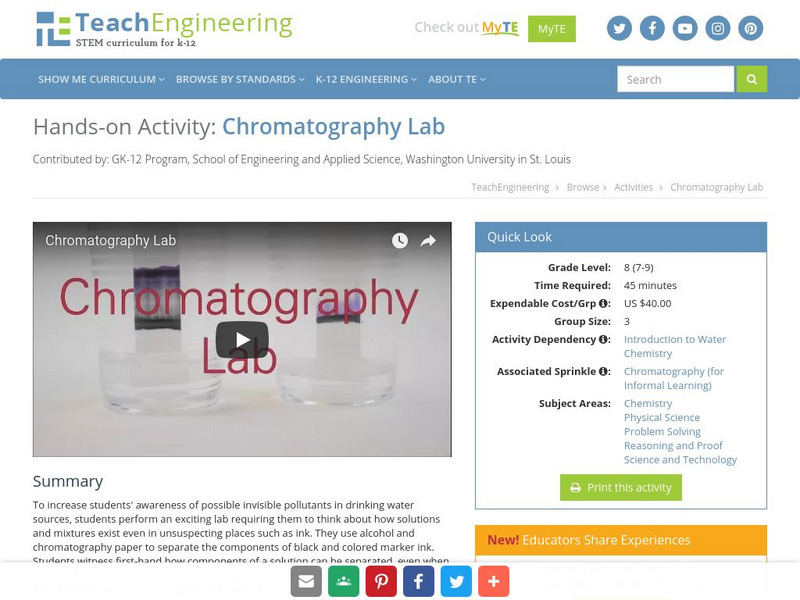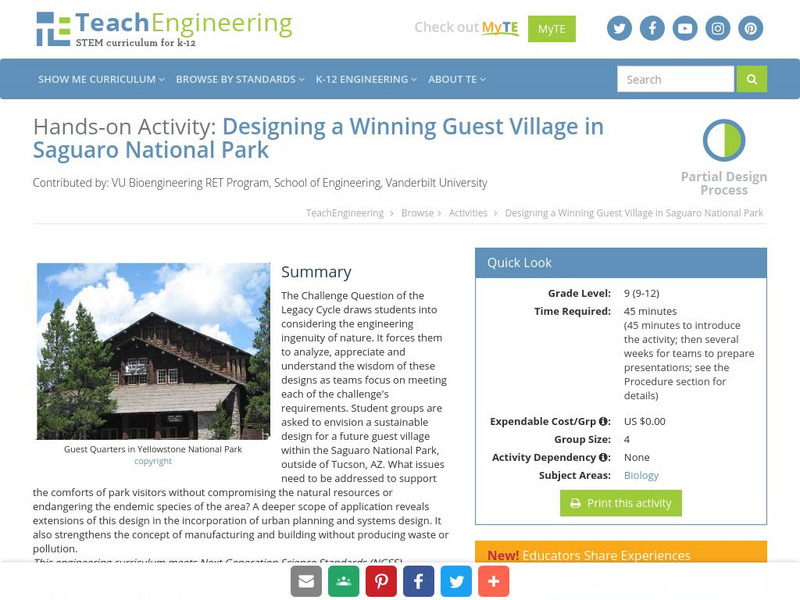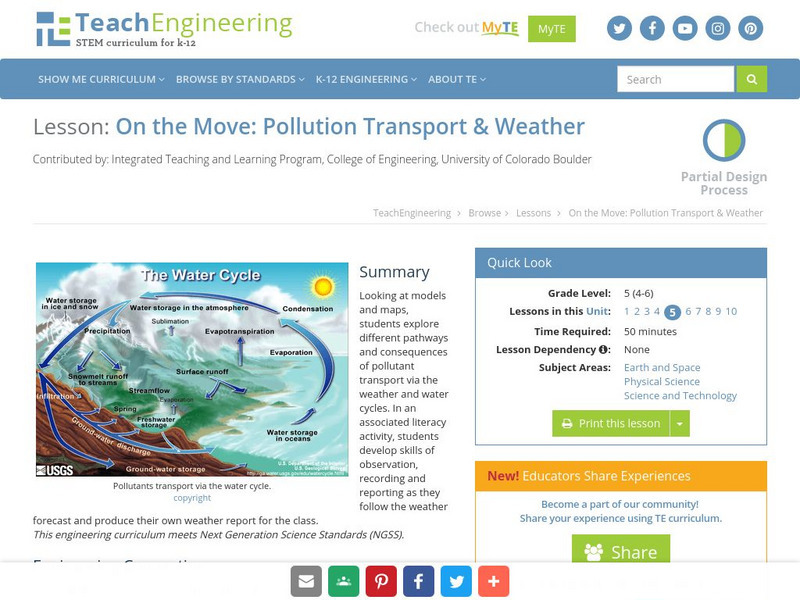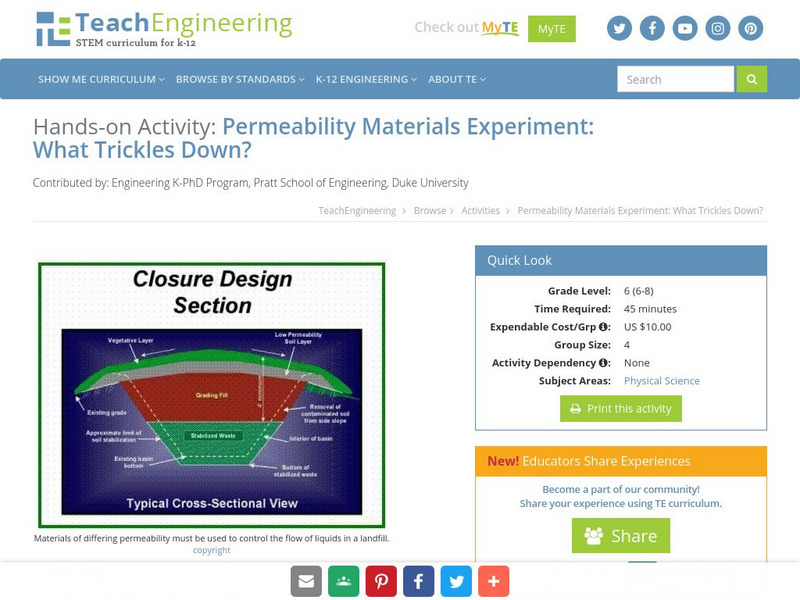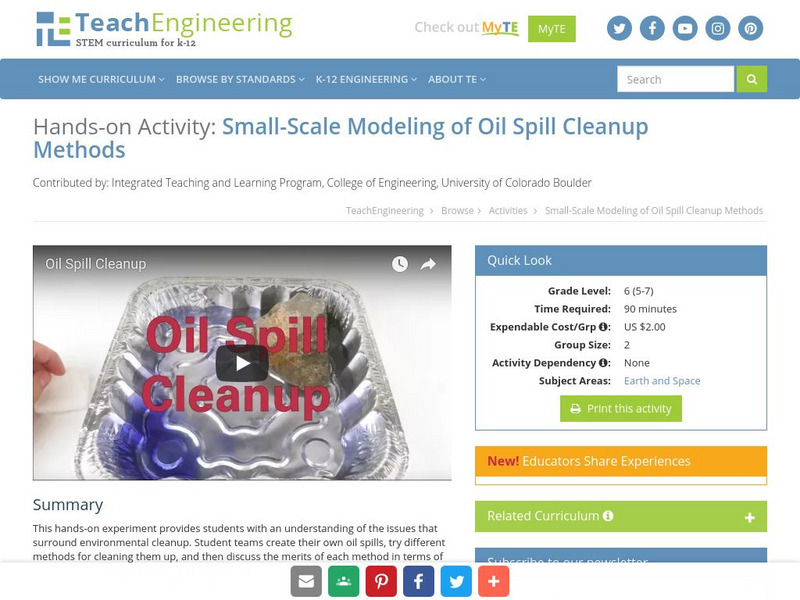TeachEngineering
Teach Engineering: Chromatography Lab
To increase students' awareness of possible invisible pollutants in drinking water sources, students perform an exciting lab requiring them to think about how solutions and mixtures exist even in unsuspecting places such as ink. They use...
TeachEngineering
Teach Engineering: Designing a Winning Guest Village in the Saguaro National Park
The Challenge Question of the Legacy Cycle draws the student into considering the engineering ingenuity of nature. It will force him to analyze, appreciate and understand the wisdom of these designs as the student team focuses on meeting...
TeachEngineering
Teach Engineering: On the Move
Looking at models and maps, students explore different pathways and consequences of pollutant transport via the weather and water cycles. In an associated literacy activity, students develop skills of observation, recording and reporting...
American Geosciences Institute
American Geosciences Institute: Earth Science Week: Hands on Experiments to Test for Acid Mine Drainage
Fifteen short experiments which test acid mine damage to the streams, rivers, and creek ecosystems surrounding it.
University Corporation for Atmospheric Research
Ucar: Learn: The Greenhouse Effect
A detailed overview of the greenhouse effect, with explanations about Earth's atmosphere gases referred to as greenhouse gases, and the factors that influence the heat-trapping ability of a greenhouse. All information is reinforced...
Science Education Resource Center at Carleton College
Serc: Can We Revive Lake Erie's "Dead Zone?"
This Ohio Sea Grant website features a WebQuest-like activity that explores the development of a dead zone, an oxygen-deprived area where there is no life, in Lake Erie. The activity aims to teach students about the processes that...
US National Archives
Docsteach: Birth of the Environmental Protection Agency (Epa)
By the late 1960s, issues of unchecked land development, urban decay, and air, noise, and water pollution came to Americans' attention. In November 1971, the newly created Environmental Protection Agency (EPA) announced a large-scale...
Other
Population Education: Homepage
Population Education provides teacher training and a variety of teacher tools to help educators on population concepts such as population growth, overpopulation, our effect on the environment, and related resources.
National Geographic
National Geographic: Sea Turtles and the Gulf of Mexico Oil Spill
After researching and comparing five species of sea turtles, students look at how they were affected by the Gulf of Mexico oil spill. Then they learn about efforts to relocate wildlife after an environmental disaster such as this, and...
TeachEngineering
Teach Engineering: Oil Spill
This activity will allow students to explore an important role of environmental engineers: cleaning the environment. Students will learn details about the Exxon Valdez oil spill, which was one of the most publicized and studied...
Science Education Resource Center at Carleton College
Serc: Mn Step: Watersheds Urban and Rural
For this activity students build models of two types of watersheds, one urban and one rural. They will then simulate rain or the water cycle and observe what happens to the 'soil.' This activity leads to discussions about the water...
Other
K 3 Learning pages.com: Earth Day Links
How can you celebrate Earth Day in your classroom? This collection features several downloadable Earth Day worksheets including word searches and coloring pages. Students and teachers can plan the perfect way to recognize the environment.
Texas Instruments
Texas Instruments: P H
Students use a pH sensor to measure the pH level of water in a stream or lake. They examine how air pollutants like sulphur dioxide, nitrogen oxides, and carbon dioxide cause acid rain, which affects the pH of water bodies and aquatic...
TeachEngineering
Teach Engineering: What Trickles Down?
Permeability is the degree to which water or other liquids are able to flow through a material. Different substances such as soil, gravel, sand, and asphalt have varying levels of permeability. In this activity, students will explore...
Science Education Resource Center at Carleton College
Serc: Ecosystem Study
Studets investigate the health of an ecosystem and the effects of water, sunlight, nutrients or pollutants. They determine the change in the environment through observation, journaling, and measuring growth of the plants and living...
TeachEngineering
Teach Engineering: Oil Spill Cleanup
This hands-on experiment will provide students with an understanding of the issues that surround environmental cleanup. Students will create their own oil spill, try different methods for cleaning it up, and then discuss the merits of...
TeachEngineering
Teach Engineering: Oil on the Ocean
Students learn about oil spills and their environmental and economic effects. They experience the steps of the engineering design process as they brainstorm potential methods for oil spill clean-up, and then design, build, and re-design...
Other
Cross Innovation Hub Hamburg: Cross Innovation Network
This platform displays cross-sectoral and cross-disciplinary innovation activities from all over Europe. Example projects include the use of algae to remove pollutants from water, harnessing thermal energy from roofs, and reusing...


